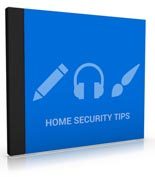
 License Type: Personal Use
License Type: Personal Use  File Type: ZIP
File Type: ZIP
 SKU: 62253
SKU: 62253  Shipping: Online Download
Shipping: Online Download
Sample Content Preview
Keep Your Home Secure While You're Away with a Video Doorbell System
The Internet and World Wide Web have been integrated into many areas of our lives, and this includes home security. There are home security systems and con-sumer electronic devices that can be hooked into your home’s Internet. This pro-vides all-day, all-night, anywhere access wherever you have an Internet connec-tion.
If your security system is compromised, you receive an immediate notification via email, text or telephone call. In many cases this notification triggers a live video feed where you can see the area of your home which caused the security system response. While these security systems are very effective, they can be costly, and most come with a monthly maintenance fee.
A simpler, less expensive and equally effective way to keep your home safe and secure is with a Wi-Fi enabled video doorbell system.
What Is a Smart Doorbell Camera?
Video doorbells, also called wireless doorbell cameras or smart doorbell cameras, are well described by their names. You are no doubt familiar with a traditional doorbell. This is a button or some other type of pressure activated device gener-ally located by the front door of a residence. A bell sounds inside the home when the doorbell is activated to let the residents know someone is at their door.
A wireless doorbell camera adds live and recorded video features plus Wi-Fi Inter-net access to a traditional doorbell. When the doorbell is pushed a bell still sounds to let the inhabitants know someone is at their door. Additionally, and more importantly for home security, a motion activated sensor triggers video capture when someone gets within a certain distance of the doorbell. Simultaneously, a live video feed begins, and the smartphone or tablet, laptop or desktop computer you have associated with your video doorbell notifies you.
This is a relatively new and very powerful home security feature that is surpris-ingly affordable considering what it allows you to do. Many smart doorbell cam-eras record video as well as broadcasting live. This means that not only can you see who is on your porch, but you also have a recorded video of whatever tran-spires afterward.
"Get Off My Porch!"
In addition to video recording, you can speak to the person who has triggered the motion sensor on your video doorbell. This happens in real time. As you are look-ing at the video of the individual in your front yard or at your front door, you can talk with them.
A potential burglar will not know if you are inside your home or half a world away. Additional features on a smart doorbell camera include the ability to share your video and audio with other people in your neighborhood, in the hopes of prevent-ing break-ins in other homes as well as your own.
Some video doorbell security systems can be integrated with Google, and Amazon voice activated consumer electronics, and prices began around just $60. A video doorbell can help you beef up your home security system without spending a lot of money, and you get 24/7 video and audio recording and interactivity whether you are at home or away.
Protecting Your Home from Cyber Crimi-nals
The smart home was supposed to revolutionize the way we live. By connecting consumer electronics, appliances, heating and cooling systems, doors, windows, and home security systems to the internet, smart homes allow global wi-fi access to your home. You can adjust your thermostat, turn lights and appliances on and off, and control your home's lighting when you are away.
Unfortunately, smart homes have not delivered on the nirvana of residential living they promised. There are compatibility issues which arise constantly depending on what type of smart home appliances and electronics you purchase, and Wi-Fi access means cyber vulnerability accompanies global accessibility.
Even if you don't live in what could be classified as a smart home, there are still ways that cybercriminals can breach your home's security without crashing through your front door or breaking in through a window. Here are a few tips and proven practices that can keep your home and family safe from Internet criminals.
Use Passphrases Instead of Passwords
People often use passwords which are personal in nature when encrypting their smartphones and computers. Passphrases are almost always harder to crack, and you can make them even more difficult for a thief to decipher by including special characters, numbers, and both upper and lowercase letters.
Use Different Passcodes for Different Sites And Devices
You may think that using a single passcode everywhere you go online makes sense because it is easy for you to remember. Just remember that this gives a cyber thief access to every website and device you use once they discover that passcode.
Set All Social Media Networking Profiles to Private
This practice just makes sense. If everything you post online can be seen by any-one anywhere in the world, how safe is your information?
Change the Default Password on Your Router
Did you know most wireless routers have their passcodes written on them? There is usually a small white label on the bottom or back of your router that has your default passcode written on it. This means anyone that is ever in your home has access to this password. Always change the default router passcode to a unique and difficult passphrase, so only you and your family members have access.







